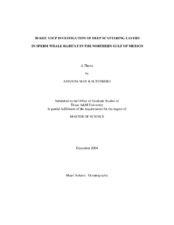| dc.description.abstract | A hull-mounted 38-kHz phased-array acoustic Doppler current profiler (ADCP) was used to acoustically survey the continental margin of the northern Gulf of Mexico (GOM) during 6 cruises in 2002-2003. This is the first backscatter survey with a 38-kHz ADCP in the Gulf of Mexico. ADCPs have been used as a proxy to measure the volume backscatter return from plankton in the water column, however previous studies were restricted to the upper 200 to 300 meters due to the relatively high frequency of operation (150-300 kHz) of the transducers. In addition to measuring deep water current velocities, the 38-kHz phased-array ADCP can measure Relative Acoustic Backscatter Intensity (RABI) as deep as 1000 meters. The daytime depth of the main deep scattering layer at 400 to 500 meters was resolved, and locally high backscatter intensity can be seen down to 800 meters. The objectives were to determine how to analyze RABI from the instrument to resolve scattering layers, and then to seek secondary deep scattering layers of potential prey species below the main deep scattering layer, from 600 to 800 meters in the feeding range for Gulf of Mexico sperm whales.
Based on RABI from the 38-kHz ADCP, secondary DSLs in sperm whale diving range were more commonly recorded over the continental shelf than in the deep basin region of the Gulf of Mexico. The daytime depths of migrating plankton showed variation depending on physical circulation features (cyclone, anticyclone, proximity to Mississippi river, and Loop Current) present. Vertical migrations compared between concurrently running 38 and 153-kHz ADCPs showed an overlap of acoustic scatterers recorded by the two instruments, however the 153-kHz instrument has much finer vertical resolution. Vertical migration rates were calculated and simultaneous net tow samples from one of the cruises was used to compare abundance estimates by the two methods. | en |


